
Question Number 4033 by Rasheed Soomro last updated on 27/Dec/15
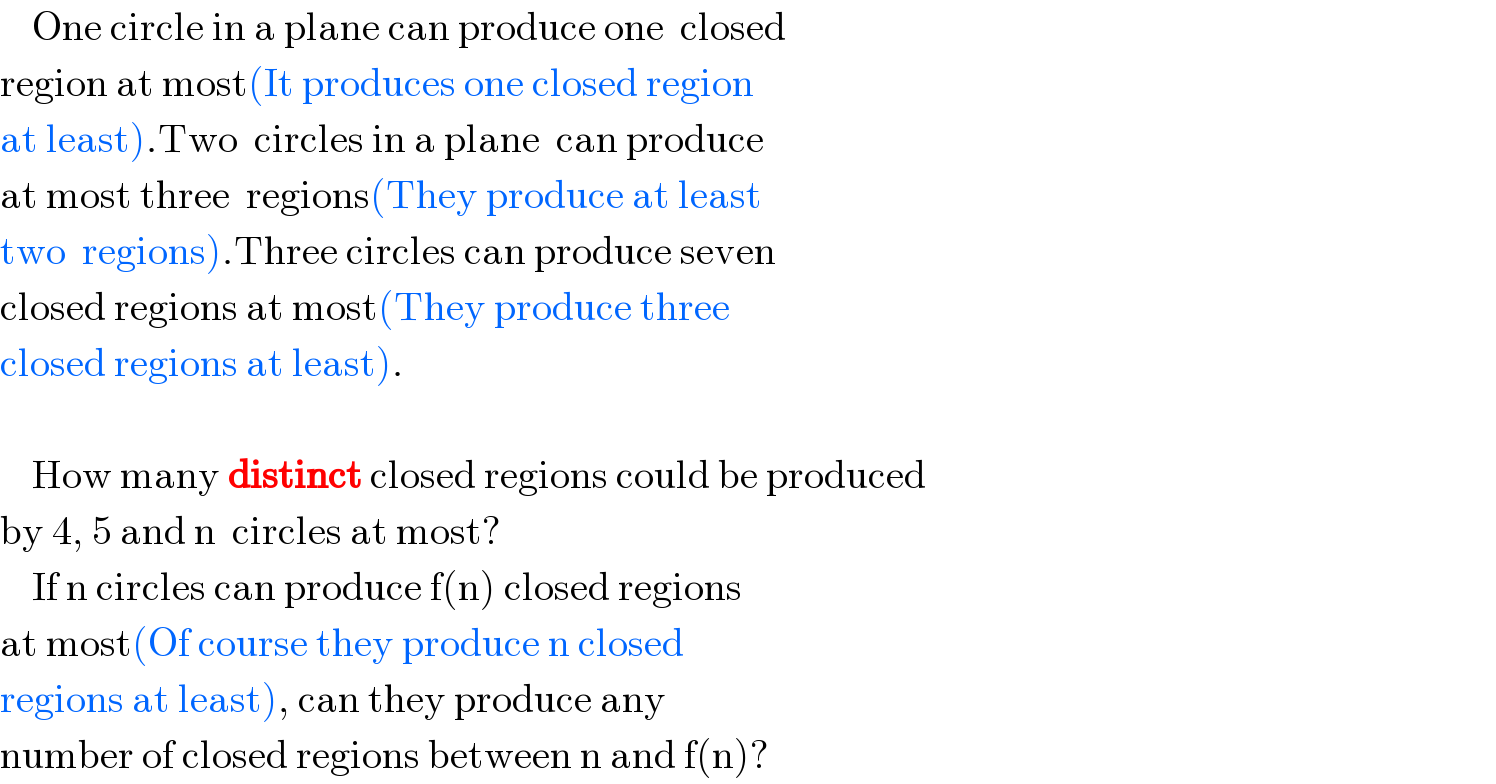
$$\:\:\:\:\mathrm{One}\:\mathrm{circle}\:\mathrm{in}\:\mathrm{a}\:\mathrm{plane}\:\mathrm{can}\:\mathrm{produce}\:\mathrm{one}\:\:\mathrm{closed} \\ $$$$\mathrm{region}\:\mathrm{at}\:\mathrm{most}\left(\mathrm{It}\:\mathrm{produces}\:\mathrm{one}\:\mathrm{closed}\:\mathrm{region}\:\right. \\ $$$$\left.\mathrm{at}\:\mathrm{least}\right).\mathrm{Two}\:\:\mathrm{circles}\:\mathrm{in}\:\mathrm{a}\:\mathrm{plane}\:\:\mathrm{can}\:\mathrm{produce} \\ $$$$\mathrm{at}\:\mathrm{most}\:\mathrm{three}\:\:\mathrm{regions}\left(\mathrm{They}\:\mathrm{produce}\:\mathrm{at}\:\mathrm{least}\right. \\ $$$$\left.\mathrm{two}\:\:\mathrm{regions}\right).\mathrm{Three}\:\mathrm{circles}\:\mathrm{can}\:\mathrm{produce}\:\mathrm{seven} \\ $$$$\mathrm{closed}\:\mathrm{regions}\:\mathrm{at}\:\mathrm{most}\left(\mathrm{They}\:\mathrm{produce}\:\mathrm{three}\right. \\ $$$$\left.\mathrm{closed}\:\mathrm{regions}\:\mathrm{at}\:\mathrm{least}\right). \\ $$$$ \\ $$$$\:\:\:\:\mathrm{How}\:\mathrm{many}\:\boldsymbol{\mathrm{distinct}}\:\mathrm{closed}\:\mathrm{regions}\:\mathrm{could}\:\mathrm{be}\:\mathrm{produced} \\ $$$$\mathrm{by}\:\mathrm{4},\:\mathrm{5}\:\mathrm{and}\:\mathrm{n}\:\:\mathrm{circles}\:\mathrm{at}\:\mathrm{most}? \\ $$$$\:\:\:\:\mathrm{If}\:\mathrm{n}\:\mathrm{circles}\:\mathrm{can}\:\mathrm{produce}\:\mathrm{f}\left(\mathrm{n}\right)\:\mathrm{closed}\:\mathrm{regions} \\ $$$$\mathrm{at}\:\mathrm{most}\left(\mathrm{Of}\:\mathrm{course}\:\mathrm{they}\:\mathrm{produce}\:\mathrm{n}\:\mathrm{closed}\right. \\ $$$$\left.\mathrm{regions}\:\mathrm{at}\:\mathrm{least}\right),\:\mathrm{can}\:\mathrm{they}\:\mathrm{produce}\:\mathrm{any} \\ $$$$\mathrm{number}\:\mathrm{of}\:\mathrm{closed}\:\mathrm{regions}\:\mathrm{between}\:\mathrm{n}\:\mathrm{and}\:\mathrm{f}\left(\mathrm{n}\right)? \\ $$
Commented by Rasheed Soomro last updated on 27/Dec/15

$$\mathrm{For}\:\mathrm{three}\:\mathrm{circles}\:\mathrm{3},\mathrm{4},\mathrm{5},\mathrm{6}\:\mathrm{and}\:\mathrm{7}\:\mathrm{closed}\:\mathrm{regions} \\ $$$$\mathrm{can}\:\mathrm{be}\:\mathrm{made}. \\ $$
Commented by Rasheed Soomro last updated on 27/Dec/15

$$\mathrm{Which}\:\mathrm{area}\:\mathrm{of}\:\mathrm{mathematics}\:\mathrm{does}\:\mathrm{this}\:\mathrm{problem} \\ $$$$\mathrm{belong}\:\mathrm{to}? \\ $$
Commented by Yozzii last updated on 27/Dec/15

Commented by Yozzii last updated on 27/Dec/15

$${I}\:{only}\:{first}\:{met}\:{this}\:{idea}\:{in}\:{set}\:{theory} \\ $$$${but}\:{f}\left({n}\right)=\mathrm{2}^{{n}} −\mathrm{1}\:{is}\:{valid}\:{only}\:{if}\:\mathrm{0}\leqslant{n}\leqslant\mathrm{3}. \\ $$$$\mathrm{4}\:{circles}\:{appear}\:{to}\:{give}\:\mathrm{13}\:{closed} \\ $$$${regions}\:{at}\:{most}. \\ $$
Commented by Yozzii last updated on 27/Dec/15

Commented by Yozzii last updated on 27/Dec/15
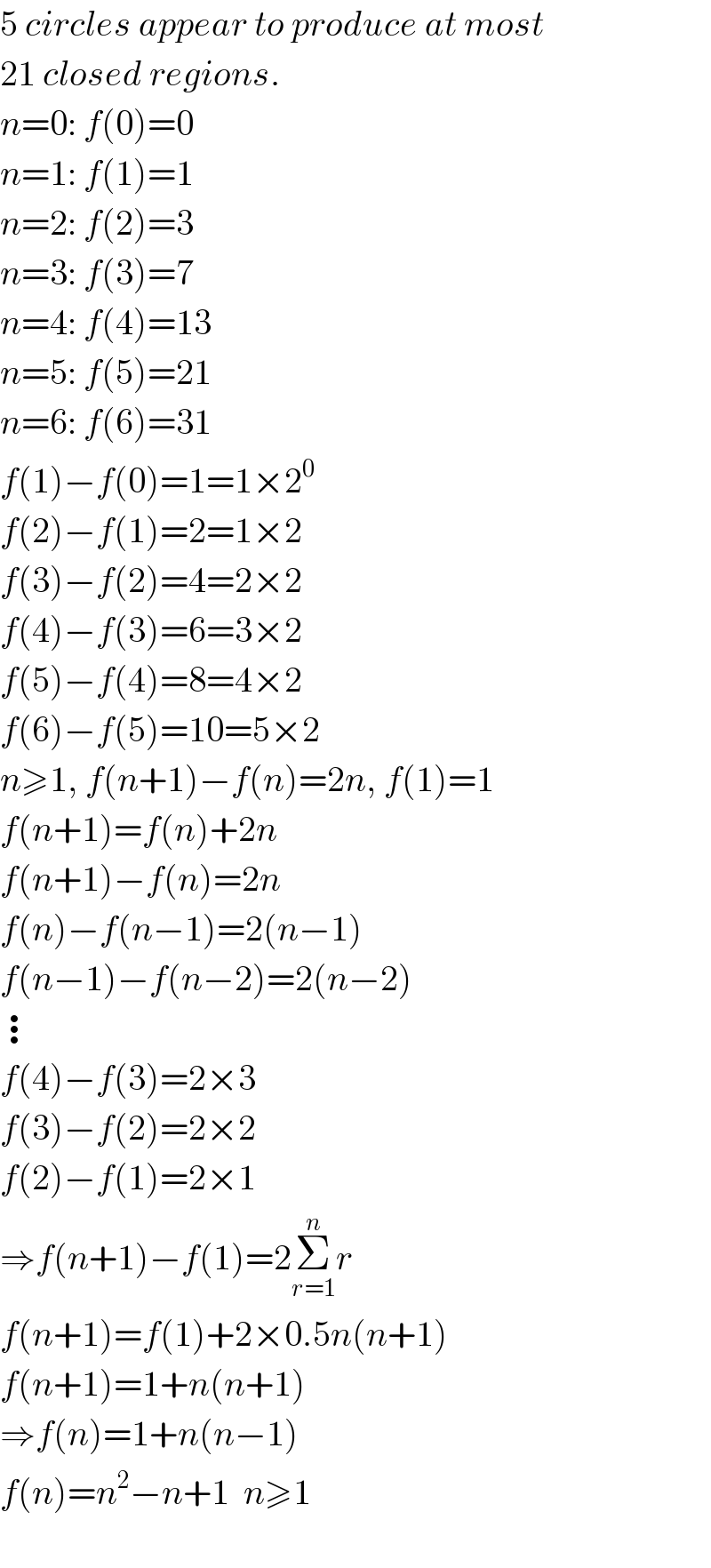
$$\mathrm{5}\:{circles}\:{appear}\:{to}\:{produce}\:{at}\:{most} \\ $$$$\mathrm{21}\:{closed}\:{regions}. \\ $$$${n}=\mathrm{0}:\:{f}\left(\mathrm{0}\right)=\mathrm{0} \\ $$$${n}=\mathrm{1}:\:{f}\left(\mathrm{1}\right)=\mathrm{1} \\ $$$${n}=\mathrm{2}:\:{f}\left(\mathrm{2}\right)=\mathrm{3} \\ $$$${n}=\mathrm{3}:\:{f}\left(\mathrm{3}\right)=\mathrm{7} \\ $$$${n}=\mathrm{4}:\:{f}\left(\mathrm{4}\right)=\mathrm{13} \\ $$$${n}=\mathrm{5}:\:{f}\left(\mathrm{5}\right)=\mathrm{21} \\ $$$${n}=\mathrm{6}:\:{f}\left(\mathrm{6}\right)=\mathrm{31} \\ $$$${f}\left(\mathrm{1}\right)−{f}\left(\mathrm{0}\right)=\mathrm{1}=\mathrm{1}×\mathrm{2}^{\mathrm{0}} \\ $$$${f}\left(\mathrm{2}\right)−{f}\left(\mathrm{1}\right)=\mathrm{2}=\mathrm{1}×\mathrm{2} \\ $$$${f}\left(\mathrm{3}\right)−{f}\left(\mathrm{2}\right)=\mathrm{4}=\mathrm{2}×\mathrm{2} \\ $$$${f}\left(\mathrm{4}\right)−{f}\left(\mathrm{3}\right)=\mathrm{6}=\mathrm{3}×\mathrm{2} \\ $$$${f}\left(\mathrm{5}\right)−{f}\left(\mathrm{4}\right)=\mathrm{8}=\mathrm{4}×\mathrm{2} \\ $$$${f}\left(\mathrm{6}\right)−{f}\left(\mathrm{5}\right)=\mathrm{10}=\mathrm{5}×\mathrm{2} \\ $$$${n}\geqslant\mathrm{1},\:{f}\left({n}+\mathrm{1}\right)−{f}\left({n}\right)=\mathrm{2}{n},\:{f}\left(\mathrm{1}\right)=\mathrm{1} \\ $$$${f}\left({n}+\mathrm{1}\right)={f}\left({n}\right)+\mathrm{2}{n} \\ $$$${f}\left({n}+\mathrm{1}\right)−{f}\left({n}\right)=\mathrm{2}{n} \\ $$$${f}\left({n}\right)−{f}\left({n}−\mathrm{1}\right)=\mathrm{2}\left({n}−\mathrm{1}\right) \\ $$$${f}\left({n}−\mathrm{1}\right)−{f}\left({n}−\mathrm{2}\right)=\mathrm{2}\left({n}−\mathrm{2}\right) \\ $$$$\vdots \\ $$$${f}\left(\mathrm{4}\right)−{f}\left(\mathrm{3}\right)=\mathrm{2}×\mathrm{3} \\ $$$${f}\left(\mathrm{3}\right)−{f}\left(\mathrm{2}\right)=\mathrm{2}×\mathrm{2} \\ $$$${f}\left(\mathrm{2}\right)−{f}\left(\mathrm{1}\right)=\mathrm{2}×\mathrm{1} \\ $$$$\Rightarrow{f}\left({n}+\mathrm{1}\right)−{f}\left(\mathrm{1}\right)=\mathrm{2}\underset{{r}=\mathrm{1}} {\overset{{n}} {\sum}}{r} \\ $$$${f}\left({n}+\mathrm{1}\right)={f}\left(\mathrm{1}\right)+\mathrm{2}×\mathrm{0}.\mathrm{5}{n}\left({n}+\mathrm{1}\right) \\ $$$${f}\left({n}+\mathrm{1}\right)=\mathrm{1}+{n}\left({n}+\mathrm{1}\right) \\ $$$$\Rightarrow{f}\left({n}\right)=\mathrm{1}+{n}\left({n}−\mathrm{1}\right) \\ $$$${f}\left({n}\right)={n}^{\mathrm{2}} −{n}+\mathrm{1}\:\:{n}\geqslant\mathrm{1} \\ $$$$ \\ $$
Commented by prakash jain last updated on 27/Dec/15
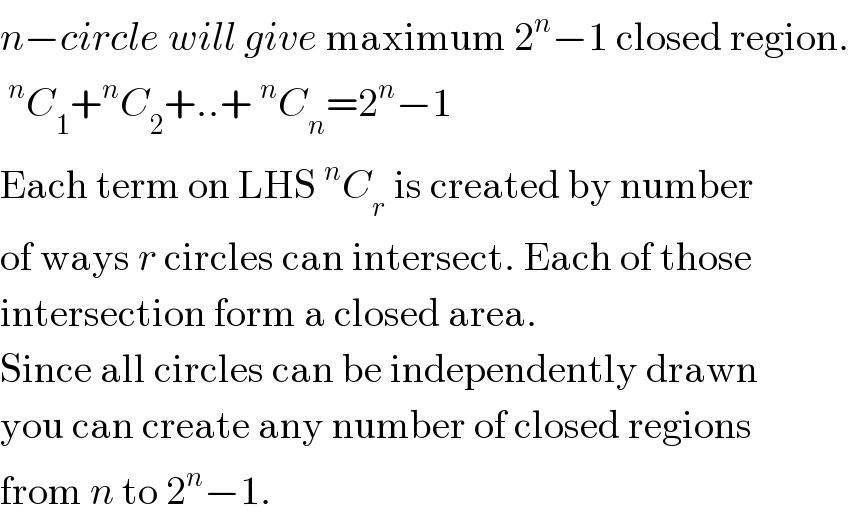
$${n}−{circle}\:{will}\:{give}\:\mathrm{maximum}\:\mathrm{2}^{{n}} −\mathrm{1}\:\mathrm{closed}\:\mathrm{region}. \\ $$$$\:^{{n}} {C}_{\mathrm{1}} +^{{n}} {C}_{\mathrm{2}} +..+\:^{{n}} {C}_{{n}} =\mathrm{2}^{{n}} −\mathrm{1} \\ $$$$\mathrm{Each}\:\mathrm{term}\:\mathrm{on}\:\mathrm{LHS}\:^{{n}} {C}_{{r}} \:\mathrm{is}\:\mathrm{created}\:\mathrm{by}\:\mathrm{number} \\ $$$$\mathrm{of}\:\mathrm{ways}\:{r}\:\mathrm{circles}\:\mathrm{can}\:\mathrm{intersect}.\:\mathrm{Each}\:\mathrm{of}\:\mathrm{those} \\ $$$$\mathrm{intersection}\:\mathrm{form}\:\mathrm{a}\:\mathrm{closed}\:\mathrm{area}. \\ $$$$\mathrm{Since}\:\mathrm{all}\:\mathrm{circles}\:\mathrm{can}\:\mathrm{be}\:\mathrm{independently}\:\mathrm{drawn} \\ $$$$\mathrm{you}\:\mathrm{can}\:\mathrm{create}\:\mathrm{any}\:\mathrm{number}\:\mathrm{of}\:\mathrm{closed}\:\mathrm{regions} \\ $$$$\mathrm{from}\:{n}\:\mathrm{to}\:\mathrm{2}^{{n}} −\mathrm{1}. \\ $$
Commented by Rasheed Soomro last updated on 27/Dec/15

$$\mathrm{But}\:\mathrm{sir}\:\mathrm{Yozzii}'\mathrm{s}\:\mathrm{experiment}\:\mathrm{shows}\:\mathrm{that}\:\mathrm{4}\:\mathrm{circles}\: \\ $$$$\mathrm{can}\:\mathrm{produce}\:\mathrm{13}\:\mathrm{closed}\:\mathrm{regions}\:\left(\mathrm{See}\:\mathrm{image}\:\mathrm{of}\right. \\ $$$$\left.\mathrm{four}\:\mathrm{circles}\:\mathrm{above}\right)\mathrm{while}\:\mathrm{your}\:\mathrm{formula}\:\mathrm{suggests}\:\mathrm{2}^{\mathrm{4}} −\mathrm{1}=\mathrm{15} \\ $$$$\mathrm{Is}\:\mathrm{there}\:\mathrm{any}\:\mathrm{mistake}\:\mathrm{in}\:\mathrm{experiment}? \\ $$
Commented by Yozzii last updated on 27/Dec/15

$${Download}\:{the}\:{application}\:{called}\:{GeoGebra}. \\ $$$${I}\:{used}\:{it}\:{to}\:{experiment}.\:{I}\:{could}\:{certainly} \\ $$$${be}\:{wrong},\:{so}\:{use}\:{the}\:{app}\:{to}\:{see}\:{for} \\ $$$${yourself}\:{how}\:{you}\:{can}\:{obtain}\:\mathrm{15}.\:{I} \\ $$$${wasn}'{t}\:{successful}\:{in}\:{obtaining}\:\mathrm{15} \\ $$$${on}\:{my}\:{own}. \\ $$
Commented by Rasheed Soomro last updated on 27/Dec/15
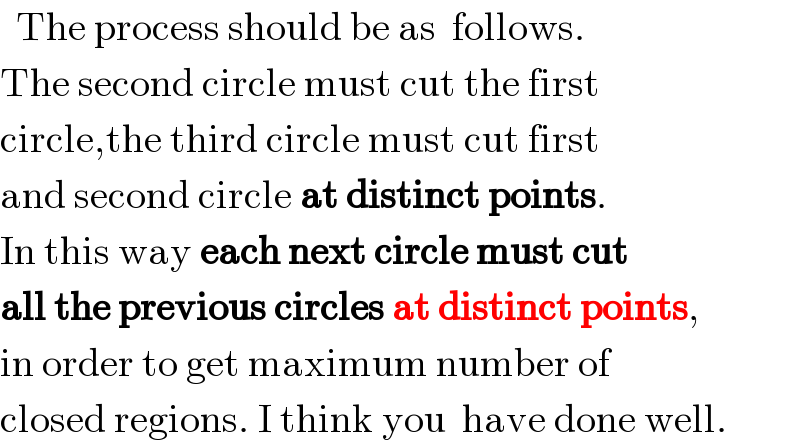
$$\:\:\mathrm{The}\:\mathrm{process}\:\mathrm{should}\:\mathrm{be}\:\mathrm{as}\:\:\mathrm{follows}. \\ $$$$\mathrm{The}\:\mathrm{second}\:\mathrm{circle}\:\mathrm{must}\:\mathrm{cut}\:\mathrm{the}\:\mathrm{first} \\ $$$$\mathrm{circle},\mathrm{the}\:\mathrm{third}\:\mathrm{circle}\:\mathrm{must}\:\mathrm{cut}\:\mathrm{first} \\ $$$$\mathrm{and}\:\mathrm{second}\:\mathrm{circle}\:\boldsymbol{\mathrm{at}}\:\boldsymbol{\mathrm{distinct}}\:\boldsymbol{\mathrm{points}}. \\ $$$$\mathrm{In}\:\mathrm{this}\:\mathrm{way}\:\boldsymbol{\mathrm{each}}\:\boldsymbol{\mathrm{next}}\:\boldsymbol{\mathrm{circle}}\:\boldsymbol{\mathrm{must}}\:\boldsymbol{\mathrm{cut}} \\ $$$$\boldsymbol{\mathrm{all}}\:\boldsymbol{\mathrm{the}}\:\boldsymbol{\mathrm{previous}}\:\boldsymbol{\mathrm{circles}}\:\boldsymbol{\mathrm{at}}\:\boldsymbol{\mathrm{distinct}}\:\boldsymbol{\mathrm{points}}, \\ $$$$\mathrm{in}\:\mathrm{order}\:\mathrm{to}\:\mathrm{get}\:\mathrm{maximum}\:\mathrm{number}\:\mathrm{of} \\ $$$$\mathrm{closed}\:\mathrm{regions}.\:\mathrm{I}\:\mathrm{think}\:\mathrm{you}\:\:\mathrm{have}\:\mathrm{done}\:\mathrm{well}. \\ $$
Commented by prakash jain last updated on 27/Dec/15
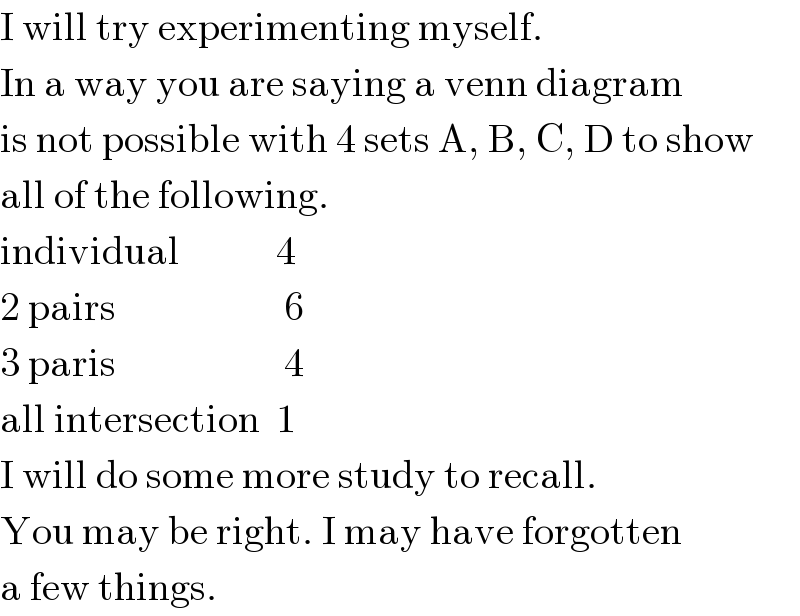
$$\mathrm{I}\:\mathrm{will}\:\mathrm{try}\:\mathrm{experimenting}\:\mathrm{myself}. \\ $$$$\mathrm{In}\:\mathrm{a}\:\mathrm{way}\:\mathrm{you}\:\mathrm{are}\:\mathrm{saying}\:\mathrm{a}\:\mathrm{venn}\:\mathrm{diagram} \\ $$$$\mathrm{is}\:\mathrm{not}\:\mathrm{possible}\:\mathrm{with}\:\mathrm{4}\:\mathrm{sets}\:\mathrm{A},\:\mathrm{B},\:\mathrm{C},\:\mathrm{D}\:\mathrm{to}\:\mathrm{show} \\ $$$$\mathrm{all}\:\mathrm{of}\:\mathrm{the}\:\mathrm{following}. \\ $$$$\mathrm{individual}\:\:\:\:\:\:\:\:\:\:\:\:\mathrm{4} \\ $$$$\mathrm{2}\:\mathrm{pairs}\:\:\:\:\:\:\:\:\:\:\:\:\:\:\:\:\:\:\:\:\:\mathrm{6} \\ $$$$\mathrm{3}\:\mathrm{paris}\:\:\:\:\:\:\:\:\:\:\:\:\:\:\:\:\:\:\:\:\:\mathrm{4} \\ $$$$\mathrm{all}\:\mathrm{intersection}\:\:\mathrm{1} \\ $$$$\mathrm{I}\:\mathrm{will}\:\mathrm{do}\:\mathrm{some}\:\mathrm{more}\:\mathrm{study}\:\mathrm{to}\:\mathrm{recall}. \\ $$$$\mathrm{You}\:\mathrm{may}\:\mathrm{be}\:\mathrm{right}.\:\mathrm{I}\:\mathrm{may}\:\mathrm{have}\:\mathrm{forgotten} \\ $$$$\mathrm{a}\:\mathrm{few}\:\mathrm{things}. \\ $$
Commented by Yozzii last updated on 27/Dec/15
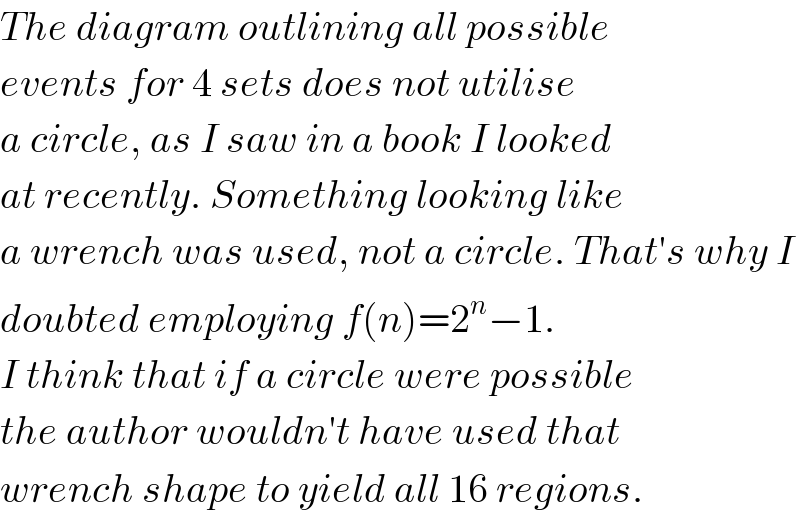
$${The}\:{diagram}\:{outlining}\:{all}\:{possible} \\ $$$${events}\:{for}\:\mathrm{4}\:{sets}\:{does}\:{not}\:{utilise} \\ $$$${a}\:{circle},\:{as}\:{I}\:{saw}\:{in}\:{a}\:{book}\:{I}\:{looked} \\ $$$${at}\:{recently}.\:{Something}\:{looking}\:{like} \\ $$$${a}\:{wrench}\:{was}\:{used},\:{not}\:{a}\:{circle}.\:{That}'{s}\:{why}\:{I} \\ $$$${doubted}\:{employing}\:{f}\left({n}\right)=\mathrm{2}^{{n}} −\mathrm{1}. \\ $$$${I}\:{think}\:{that}\:{if}\:{a}\:{circle}\:{were}\:{possible} \\ $$$${the}\:{author}\:{wouldn}'{t}\:{have}\:{used}\:{that} \\ $$$${wrench}\:{shape}\:{to}\:{yield}\:{all}\:\mathrm{16}\:{regions}. \\ $$
Commented by prakash jain last updated on 27/Dec/15

$$\mathrm{You}\:\mathrm{are}\:\mathrm{correct}\:{n}\:\mathrm{circle}\:\mathrm{can}\:\mathrm{at}\:\mathrm{most} \\ $$$$\mathrm{creat}={n}^{\mathrm{2}} −{n}+\mathrm{2}\:\mathrm{regions}. \\ $$
Commented by Yozzii last updated on 27/Dec/15

$${Including}\:{external}\:{region}\:{right}? \\ $$
Commented by prakash jain last updated on 27/Dec/15

$$\mathrm{Yes}. \\ $$
